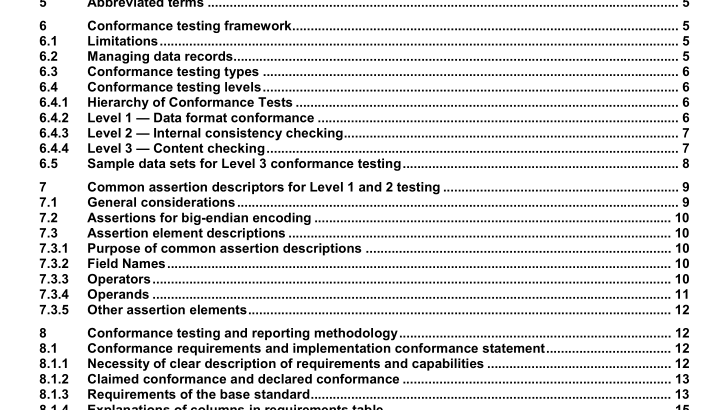ISO IEC 29109-1:2009 pdf download – Information technology — Conformance testing methodology for biometric data interchange formats defined in ISO/IEC 19794 — Part 1: Generalized conformance testing methodology
6.3 Conformance testing types Generally, the goal of biometric data interchange format conformance testing is to assure the end users of conformant biometric products that a BDIR produced by any conformant product can be interpreted and used correctly by any other conformant product. There are thus two types of fundamental conformance claims. Type A is the ability to produce conformant BDIRs and Type B is the ability to use conformant BDIRs. Different IUTs may have different purposes for which they use a conformant BDIR, and thus Type B testing is more complex than Type A testing because it must account for all of these purposes. Type B testing is therefore a topic of ongoing research, and this standard is focused on Type A testing exclusively. When biometric data interchange records themselves are tested in the absence of any software or hardware that produced them or uses them, this is treated as Type A testing. 6.4 Conformance testing levels
6.4.1 Hierarchy of Conformance Tests A first step towards the goal of demonstrating conformance is ensuring that all of the specified fields and data structures in the BDIR are correct and self-consistent. This does not validate the fidelity of the information contained in the BDIR, however, since that depends on the relationship between the original IBDR and the BDIR. This leads to a natural hierarchy of conformance testing levels. The conformance testing hierarchy presented in this standard has three levels. Generally they progress from least complex and expensive to test to most complex and expensive to test. They also progress from less useful in predicting the performance of real world systems using conformant products, to more useful, although even Level 1 conformance testing represents a significant step towards that goal.
The types of assertions for Level 1 and Level 2 testing for all parts of ISO/IEC 19794 are similar and so a list of assertion operators and operands that can be used to define assertions is given in Clause 7 of this part of ISO/IEC 29109. The details of all the Level 1 and Level 2 assertions for each base standard are given in the appropriate subsequent parts of ISO/IEC 29109. For the more complex Level 3 testing, where the actual fidelity of the information in the BDIR is compared to that in the IBDR, the subsequent parts of ISO/IEC 29109 may provide, as far as it is possible, guidance on how to carry out Level 3 testing for their specific data interchange formats. A given conformance test may therefore involve conformance testing at different levels. It will ultimately be up to application profiles or to individual end users of ISO/IEC 19794 to determine which level of conformance testing will be required for a specific application, as well as any requirements on performance or interoperability. This will be dependent on time, cost, importance of biometric performance, implications of non-interoperability and the current state of the published versions of the various parts of ISO/IEC 29109.
6.4.2 Level 1 — Data format conformance In Level 1 testing, a set of BDIRs shall be checked for field-by-field and byte-by-byte conformance with the specification of the base standard, both in terms of fields included and the ranges of the values in those fields. The specific assertions tested for each base standard shall be those described in the appropriate part of ISO/IEC 29109. The advantage of this testing is that it does not require an IUT to be a computer algorithm or a set of hardware and software. It can simply be a set of BDIRs. Thus, any hardware or software components of the implementation being tested do not have to come into the possession of the testing lab, only BDIRs created with those components.
